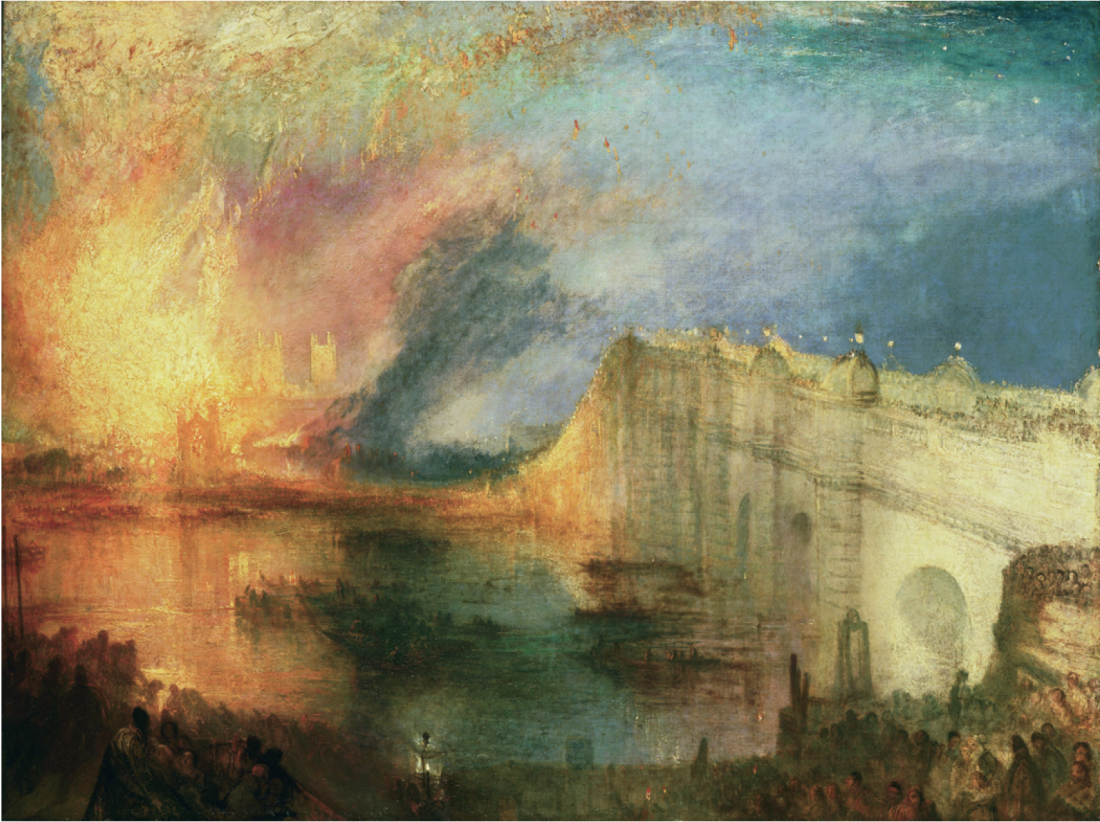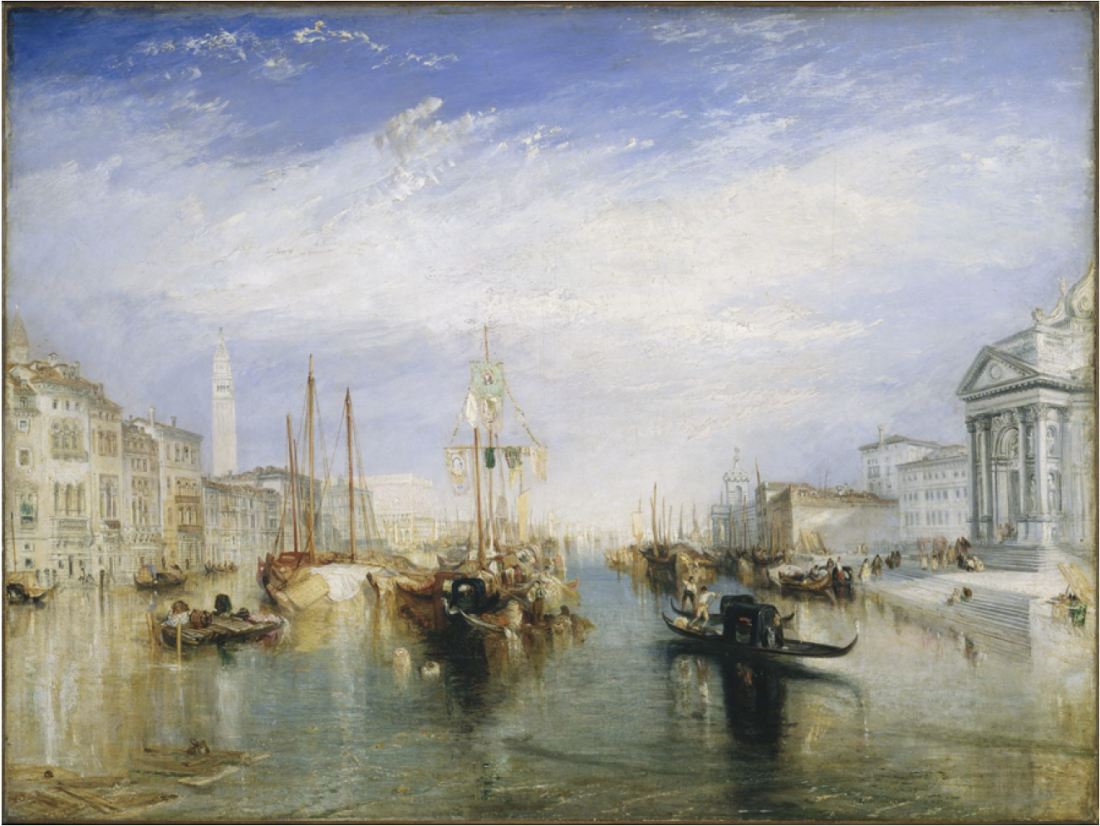JMW Turner
A poster of Salvador Dali’s Swans Reflecting Elephants, a black and white photo of Marilyn Monroe leaning like a feline up against a door frame, and a swim-suited, cleavage-baring Farrah Fawcett—all, among other delights, graced the walls of my teenage bedroom. So did JMW Turner’s The Fighting Temeraire. And, though devoid of sexual content, this work’s passion and fire left an indelible mark on me. So it was with some disappointment that I failed to find this and another favourite Rain, Steam, and Speed with its famed rabbit in the foreground, among the paintings displayed in the JMW Turner recent retrospective at the Metropolitan Museum in New York. T
his said, there was no shortage of the sublime. Ulysses Deriding Polyphemus – Homer’s Odyssey, for example, contains a sky that critic and early Turner champion John Ruskin called “beyond comparison the finest that exists in Turner’s oil-paintings.” From seascapes and mountain tops to naval battles, historical Greek settings and wild imaginative abstractions, this exhibition authoritatively traces the evolution of Joseph Mallord William Turner’s varying style and choice of subject matter, with representative sampling from a truly herculean output over a career that lasted more than 60 years. Much in the exhibition is literally brilliant. These paintings effortlessly captivate spectators moth-like within their orb.
Born in London in 1775, Turner spent his early childhood in Covent Garden, where his father had a barber shop. At an early age he showed talent for sketching and worked for a time as an architect’s draftsman. At 14 he enrolled in London’s Royal Academy of Arts. In 1802 he became the youngest artist to be elected as a full Academician. Encouraged to study the techniques of the Old Masters, Turner chose to emulate the idealized landscapes of Claude Lorrain (c.1602–1682). These were to serve as a touchstone throughout his lifetime.

Joseph Mallord William Turner, The Burning of the Houses of Lords and Commons, 16th October, 1834, exhibited 1835, oil on canvas, 36 ½ x 48 ½”. Philadelphia Museum of Art, The John Howard McFadden Collection, 1928.
In addition to dominating landscape art during the first half of the 19th century, Turner, with his technical innovations in watercolor, had a profound impact on artistic development, particularly so in France, where painters such as Degas, Monet, Pissarro and Renoir pointedly credited him for influencing their work, notably with his depictions of the reality of form in movement and the fugitive phenomena of light.
Dazzled by a wall-filling image of Venice, from the Porch of Madonna della Salute, I was awed by this show before even stepping into its exhibition space. A clamour of eager, gate-crowding patrons milled around and filled, like Times Square, the entrance area, a testament to the excitement stirred by the exhibit. Though the painting’s watery foreground was obscured by an ocean of people, Turner’s sky and buildings remained radiantly visible, proof that they easily match his much vaunted seas and waterscapes, of which Ruskin once said: “The surface of quiet water with other painters becomes fixed. With Turner it looks as if a fairy’s breath would stir it, but the fairy’s breath is not there.”
Many of the works Turner exhibited at the Royal Academy—those which established his reputation and ensured immortality—were on display—Fishermen at Sea (1796, Tate), the luminous The Burning of the Houses of Lords and Commons, 16th October 1834 (1835, Philadelphia Museum of Art) and Keelmen Heaving in Coals by Moonlight (1835, National Gallery of Art, Washington, D.C). So were his “color beginnings,” studies for subsequent paintings and his finished watercolors.

Joseph Mallord William Turner, Venice, from the Porch of Madonna della Salute, exhibited 1835, oil on canvas, 36 x 48 1/8”. The Metropolitan Museum of Art, New York, bequest of Cornelius Vanderbilt, 1899.
The exhibition was organized thematically and chronologically, beginning with early Sublime and historical landscapes and ending with late seascapes and blinding, abstract and very modern unfinished works. Early on, in an exquisite watercolour depiction of Tintern Abbey in South Wales, his skilled draftsmanship is at play. Also his penchant for clouds and majestic settings, for example, in The Pass of St. Gothard, painted in the Swiss Alps (and owned I might add with surging pride by a private collector in Canada). These have an almost Blakean feel to them and evidence an attempt at what 18th-century philosopher Edmund Burke called the sublime: the conveying of “astonishment and terror, or the strongest emotion of which the mind is capable of feeling.”
Perhaps because of its greater capacity to convey drama and depth, and its prestige, Turner moved from watercolours to painting in oil. The first of these to be exhibited at the Royal Academy in 1796 was Fishermen at Sea. It contained elements that would fill his canvases for the next half century. The way moonlight hits the ocean is wondrous. The waves in this and other seascapes of the same period are reminiscent of Gustave Courbet’s paintings of the period, just miles away across the Channel—muscular and alive. Also in the exhibit were depictions of historical landscapes and significant contemporary events, such as the Battle of Waterloo and the blazing The Burning of the Houses of Lords and Commons, a painting worth sitting in front of for hours.
With Turner’s visit to Italy there is a marked shift in palette. We see softer, warmer colours, and brush strokes. There are fewer clouds, too. His strengths remain: breathtaking skies, sunsets and light, in weather fair and foul, reflected in water. These fill the senses to a point where the odd sail out of sync, a disproportionately small boat, or a pale background just don’t matter. Nor does the fact that people, though inconsequential in most paintings, at times appear sketchy, under-drawn, grotesque, like Pieter Bruegel’s. Given Turner’s prodigious output, it is easy to see why critics would have charged that in some instances his work was unfinished, even coarse. The pleasant irony here is, as we come to the end of the exhibit and the so-called unfinished work, we are treated to what is possibly the most completely sublime experience of the afternoon. ■
“JMW Turner” was exhibited at the Metropolitan Museum of Art in New York from July 1 to September 21, 2008.
Nigel Beale is a freelance writer/ broadcaster. He lives in Ottawa.

